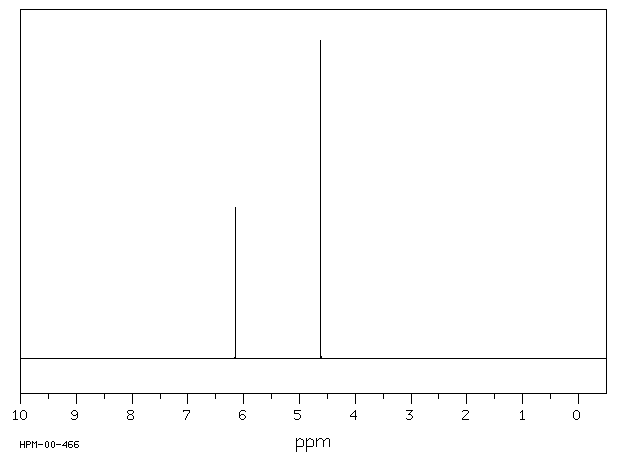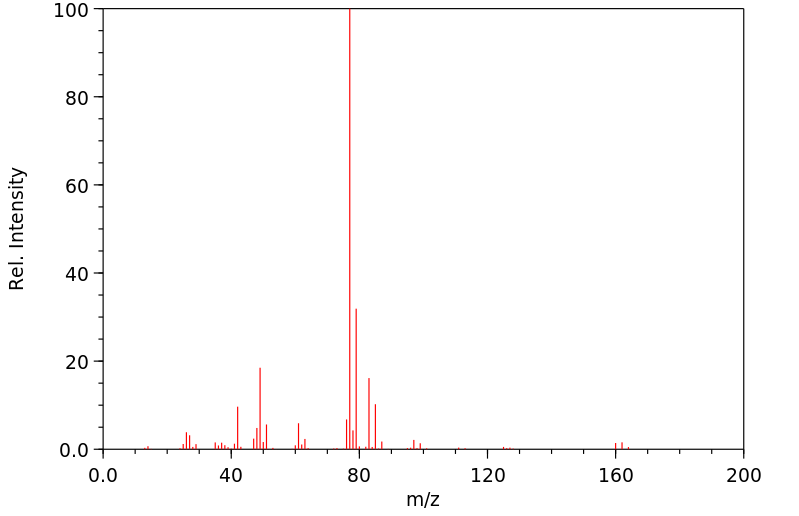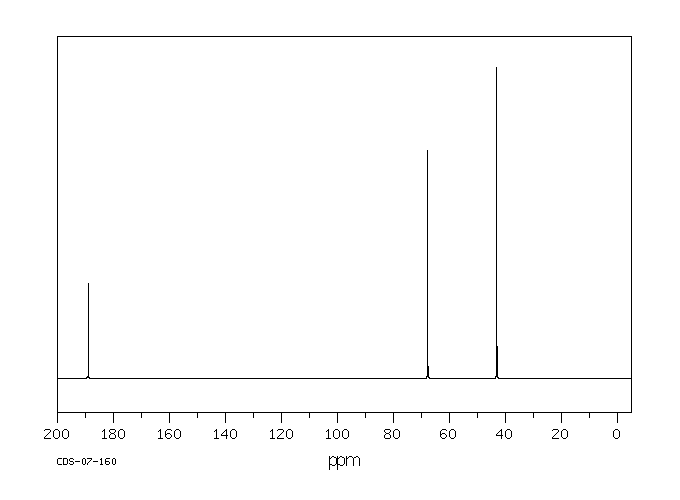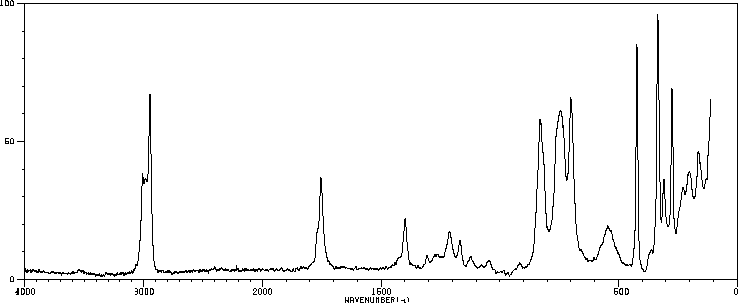1,1,3-三氯丙酮 | 921-03-9
中文名称
1,1,3-三氯丙酮
中文别名
1,1,3-三氯-2-丙酮;三氯丙酮
英文名称
1,1,3-trichloroacetone
英文别名
1,1,3-trichloro-2-propanone;1,1,3-Trichloro-2-propanon;1,1,3-trichloropropan-2-one
CAS
921-03-9
化学式
C3H3Cl3O
mdl
MFCD00040500
分子量
161.415
InChiKey
ZWILTCXCTVMANU-UHFFFAOYSA-N
BEILSTEIN
——
EINECS
——
-
物化性质
-
计算性质
-
ADMET
-
安全信息
-
SDS
-
制备方法与用途
-
上下游信息
-
文献信息
-
表征谱图
-
同类化合物
-
相关功能分类
-
相关结构分类
物化性质
-
熔点:9-11 °C(lit.)
-
沸点:88-90 °C76 mm Hg(lit.)
-
密度:1.512 g/mL at 20 °C(lit.)
-
闪点:80
-
溶解度:可溶于氯仿、甲醇
-
LogP:0.45
-
保留指数:940;936.8
-
稳定性/保质期:
常温常压下稳定,避免与强氧化剂及强碱接触。
计算性质
-
辛醇/水分配系数(LogP):1.9
-
重原子数:7
-
可旋转键数:2
-
环数:0.0
-
sp3杂化的碳原子比例:0.666
-
拓扑面积:17.1
-
氢给体数:0
-
氢受体数:1
安全信息
-
危险等级:6.1(b)
-
危险品标志:T+,N
-
安全说明:S26,S36/37/39,S45,S60,S61
-
危险类别码:R26,R34,R25,R50/53
-
WGK Germany:3
-
海关编码:2914700090
-
危险品运输编号:UN 3390 6.1/PG 1
-
危险类别:6.1(b)
-
RTECS号:UC3840000
-
包装等级:III
-
储存条件:请将容器密封保存,并存放在阴凉、干燥处。
SDS
1,1,3-三氯丙酮 修改号码:2
模块 1. 化学品
产品名称: 1,1,3-Trichloroacetone
营业部
修改号码: 2
模块 2. 危险性概述
GHS分类
物理性危害
易燃液体 第4级
健康危害
急性毒性(经口) 第3级
急性毒性(吸入) 第1级
皮肤腐蚀/刺激 1B类
严重损伤/刺激眼睛 第1级
环境危害
急性水生毒性 第1级
慢性水生毒性 第1级
GHS标签元素
图标或危害标志
信号词 危险
危险描述 可燃液体
吞咽会中毒。
吸入致命
造成严重的皮肤灼伤和眼损伤
对水生生物有极毒性
长期影响对水生生物有极毒性
防范说明
1,1,3-三氯丙酮 修改号码:2
模块 2. 危险性概述
[预防] 远离明火/热表面。
切勿吸入。
只能在室外或通风良好的环境下使用。
避免释放到环境中。
使用本产品时切勿吃东西,喝水或吸烟。
处理后要彻底清洗双手。
佩戴防护面具。
穿戴防护手套/护目镜/防护面具。
[急救措施] 吸入:将受害者移到新鲜空气处,在呼吸舒适的地方保持休息。立即呼叫解毒中心/医
生。
食入:立即呼叫解毒中心/医生。
眼睛接触:用水小心清洗几分钟。如果方便,易操作,摘除隐形眼镜。继续冲洗。
皮肤接触:立即去除/脱掉所有被污染的衣物。用水清洗皮肤/淋浴。
被污染的衣物清洗后方可重新使用。
立即呼叫解毒中心/医生。
收集溢出物。
[储存] 存放于通风良好处。保持容器密闭。
存放处须加锁。
[废弃处置] 根据当地政府规定把物品/容器交与工业废弃处理机构。
模块 3. 成分/组成信息
单一物质/混和物 单一物质
化学名(中文名): 1,1,3-三氯丙酮
百分比: >84.0%(GC)
CAS编码: 921-03-9
俗名: 1,1,3-Trichloro-2-propanone
分子式: C3H3Cl3O
模块 4. 急救措施
吸入: 将受害者移到新鲜空气处,保持呼吸通畅,休息。立即呼叫解毒中心/医生。
皮肤接触: 立即去除/脱掉所有被污染的衣物。用大量肥皂和水轻轻洗。
立即呼叫解毒中心/医生。
眼睛接触: 用水小心清洗几分钟。如果方便,易操作,摘除隐形眼镜。继续清洗。
立即呼叫解毒中心/医生。
食入: 立即呼叫解毒中心/医生。漱口。
紧急救助者的防护: 救援者需要穿戴个人防护用品,比如橡胶手套和气密性护目镜。
模块 5. 消防措施
合适的灭火剂: 干粉,泡沫,雾状水,二氧化碳
不适用的灭火剂: 棒状水
特殊危险性: 小心,燃烧或高温下可能分解产生毒烟。
特定方法: 从上风处灭火,根据周围环境选择合适的灭火方法。
非相关人员应该撤离至安全地方。
周围一旦着火:如果安全,移去可移动容器。
消防员的特殊防护用具: 灭火时,一定要穿戴个人防护用品。
1,1,3-三氯丙酮 修改号码:2
模块 6. 泄漏应急处理
个人防护措施,防护用具, 使用特殊的个人防护用品(自携式呼吸器)。远离溢出物/泄露处并处在上风处。确保
紧急措施: 足够通风。
泄露区应该用安全带等圈起来,控制非相关人员进入。
环保措施: 小心,切勿排入河流等。因为考虑对环境有负面影响。
控制和清洗的方法和材料: 用合适的吸收剂(如:旧布,干砂,土,锯屑)吸收泄漏物。一旦大量泄漏,筑堤控制。
附着物或收集物应该立即根据合适的法律法规废弃处置。
副危险性的防护措施 移除所有火源。一旦发生火灾应该准备灭火器。使用防火花工具和防爆设备。
模块 7. 操作处置与储存
处理
技术措施: 在通风良好处进行处理。穿戴合适的防护用具。防止烟雾产生。远离明火和热表面。采
取措施防止静电积累。使用防爆设备。处理后彻底清洗双手和脸。
注意事项: 使用封闭系统,通风。
操作处置注意事项: 避免接触皮肤、眼睛和衣物。
贮存
储存条件: 保持容器密闭。存放于凉爽、阴暗、通风良好处。
存放于惰性气体环境中。
存放处须加锁。
远离不相容的材料比如氧化剂存放。
包装材料: 依据法律。
模块 8. 接触控制和个体防护
工程控制: 尽可能安装封闭体系或局部排风系统。同时安装淋浴器和洗眼器。
个人防护用品
呼吸系统防护: 半面罩或全面罩呼吸器,自携式呼吸器(SCBA),供气呼吸器等。依据当地和政府法规,
使用通过政府标准的呼吸器。
手部防护: 防渗手套。
眼睛防护: 护目镜。如果情况需要,佩戴面具。
皮肤和身体防护: 防渗防护服。如果情况需要,穿戴防护靴。
模块 9. 理化特性
外形(20°C):
液体
外观: 透明
颜色: 无色-微浅黄色
气味: 无资料
pH: 无数据资料
熔点: 无资料
沸点/沸程 172 °C
闪点: 80°C
爆炸特性
爆炸下限: 6.3%
爆炸上限: 无资料
密度: 1.53
溶解度: 无资料
模块 10. 稳定性和反应性
稳定性: 一般情况下稳定。
反应性: 未报道特殊反应性。
避免接触的条件: 气敏
1,1,3-三氯丙酮 修改号码:2
模块 10. 稳定性和反应性
须避免接触的物质 氧化剂, 碱
危险的分解产物: 一氧化碳, 二氧化碳, 氯化氢
模块 11. 毒理学信息
ihl-mus LC50:360 mg/m3/2H
急性毒性:
ihl-rat LC50:390 mg/m3/2H
对皮肤腐蚀或刺激: 无资料
对眼睛严重损害或刺激: 无资料
生殖细胞变异原性: mmo-sat 50 ug/plate (+S9)
mrc-smc 5 ug/L
致癌性:
IARC = 无资料
NTP = 无资料
生殖毒性: 无资料
RTECS 号码: UC3840000
模块 12. 生态学信息
生态毒性:
鱼类: 无资料
甲壳类: 无资料
藻类: 无资料
残留性 / 降解性: 无资料
潜在生物累积 (BCF): 无资料
土壤中移动性
log水分配系数: 无资料
土壤吸收系数 (Koc): 无资料
亨利定律 无资料
constaNT(PaM3/mol):
模块 13. 废弃处置
如果可能,回收处理。请咨询当地管理部门。建议在装有后燃和洗涤装置的化学焚烧炉中焚烧。废弃处置时请遵守国
家、地区和当地的所有法规。
模块 14. 运输信息
联合国分类: 第1项 毒害品。
副危险性: 第8类 腐蚀品
UN编号: 3390
正式运输名称: 吸入液体有毒, 腐蚀的, 不另作详细说明
模块 15. 法规信息
《危险化学品安全管理条例》(2002年1月26日国务院发布): 针对危险化学品的安全使用、生产、储存、运输、装卸
等方面均作了相应的规定。
1,1,3-三氯丙酮 修改号码:2
模块16 - 其他信息
N/A
模块 1. 化学品
产品名称: 1,1,3-Trichloroacetone
营业部
修改号码: 2
模块 2. 危险性概述
GHS分类
物理性危害
易燃液体 第4级
健康危害
急性毒性(经口) 第3级
急性毒性(吸入) 第1级
皮肤腐蚀/刺激 1B类
严重损伤/刺激眼睛 第1级
环境危害
急性水生毒性 第1级
慢性水生毒性 第1级
GHS标签元素
图标或危害标志
信号词 危险
危险描述 可燃液体
吞咽会中毒。
吸入致命
造成严重的皮肤灼伤和眼损伤
对水生生物有极毒性
长期影响对水生生物有极毒性
防范说明
1,1,3-三氯丙酮 修改号码:2
模块 2. 危险性概述
[预防] 远离明火/热表面。
切勿吸入。
只能在室外或通风良好的环境下使用。
避免释放到环境中。
使用本产品时切勿吃东西,喝水或吸烟。
处理后要彻底清洗双手。
佩戴防护面具。
穿戴防护手套/护目镜/防护面具。
[急救措施] 吸入:将受害者移到新鲜空气处,在呼吸舒适的地方保持休息。立即呼叫解毒中心/医
生。
食入:立即呼叫解毒中心/医生。
眼睛接触:用水小心清洗几分钟。如果方便,易操作,摘除隐形眼镜。继续冲洗。
皮肤接触:立即去除/脱掉所有被污染的衣物。用水清洗皮肤/淋浴。
被污染的衣物清洗后方可重新使用。
立即呼叫解毒中心/医生。
收集溢出物。
[储存] 存放于通风良好处。保持容器密闭。
存放处须加锁。
[废弃处置] 根据当地政府规定把物品/容器交与工业废弃处理机构。
模块 3. 成分/组成信息
单一物质/混和物 单一物质
化学名(中文名): 1,1,3-三氯丙酮
百分比: >84.0%(GC)
CAS编码: 921-03-9
俗名: 1,1,3-Trichloro-2-propanone
分子式: C3H3Cl3O
模块 4. 急救措施
吸入: 将受害者移到新鲜空气处,保持呼吸通畅,休息。立即呼叫解毒中心/医生。
皮肤接触: 立即去除/脱掉所有被污染的衣物。用大量肥皂和水轻轻洗。
立即呼叫解毒中心/医生。
眼睛接触: 用水小心清洗几分钟。如果方便,易操作,摘除隐形眼镜。继续清洗。
立即呼叫解毒中心/医生。
食入: 立即呼叫解毒中心/医生。漱口。
紧急救助者的防护: 救援者需要穿戴个人防护用品,比如橡胶手套和气密性护目镜。
模块 5. 消防措施
合适的灭火剂: 干粉,泡沫,雾状水,二氧化碳
不适用的灭火剂: 棒状水
特殊危险性: 小心,燃烧或高温下可能分解产生毒烟。
特定方法: 从上风处灭火,根据周围环境选择合适的灭火方法。
非相关人员应该撤离至安全地方。
周围一旦着火:如果安全,移去可移动容器。
消防员的特殊防护用具: 灭火时,一定要穿戴个人防护用品。
1,1,3-三氯丙酮 修改号码:2
模块 6. 泄漏应急处理
个人防护措施,防护用具, 使用特殊的个人防护用品(自携式呼吸器)。远离溢出物/泄露处并处在上风处。确保
紧急措施: 足够通风。
泄露区应该用安全带等圈起来,控制非相关人员进入。
环保措施: 小心,切勿排入河流等。因为考虑对环境有负面影响。
控制和清洗的方法和材料: 用合适的吸收剂(如:旧布,干砂,土,锯屑)吸收泄漏物。一旦大量泄漏,筑堤控制。
附着物或收集物应该立即根据合适的法律法规废弃处置。
副危险性的防护措施 移除所有火源。一旦发生火灾应该准备灭火器。使用防火花工具和防爆设备。
模块 7. 操作处置与储存
处理
技术措施: 在通风良好处进行处理。穿戴合适的防护用具。防止烟雾产生。远离明火和热表面。采
取措施防止静电积累。使用防爆设备。处理后彻底清洗双手和脸。
注意事项: 使用封闭系统,通风。
操作处置注意事项: 避免接触皮肤、眼睛和衣物。
贮存
储存条件: 保持容器密闭。存放于凉爽、阴暗、通风良好处。
存放于惰性气体环境中。
存放处须加锁。
远离不相容的材料比如氧化剂存放。
包装材料: 依据法律。
模块 8. 接触控制和个体防护
工程控制: 尽可能安装封闭体系或局部排风系统。同时安装淋浴器和洗眼器。
个人防护用品
呼吸系统防护: 半面罩或全面罩呼吸器,自携式呼吸器(SCBA),供气呼吸器等。依据当地和政府法规,
使用通过政府标准的呼吸器。
手部防护: 防渗手套。
眼睛防护: 护目镜。如果情况需要,佩戴面具。
皮肤和身体防护: 防渗防护服。如果情况需要,穿戴防护靴。
模块 9. 理化特性
外形(20°C):
液体
外观: 透明
颜色: 无色-微浅黄色
气味: 无资料
pH: 无数据资料
熔点: 无资料
沸点/沸程 172 °C
闪点: 80°C
爆炸特性
爆炸下限: 6.3%
爆炸上限: 无资料
密度: 1.53
溶解度: 无资料
模块 10. 稳定性和反应性
稳定性: 一般情况下稳定。
反应性: 未报道特殊反应性。
避免接触的条件: 气敏
1,1,3-三氯丙酮 修改号码:2
模块 10. 稳定性和反应性
须避免接触的物质 氧化剂, 碱
危险的分解产物: 一氧化碳, 二氧化碳, 氯化氢
模块 11. 毒理学信息
ihl-mus LC50:360 mg/m3/2H
急性毒性:
ihl-rat LC50:390 mg/m3/2H
对皮肤腐蚀或刺激: 无资料
对眼睛严重损害或刺激: 无资料
生殖细胞变异原性: mmo-sat 50 ug/plate (+S9)
mrc-smc 5 ug/L
致癌性:
IARC = 无资料
NTP = 无资料
生殖毒性: 无资料
RTECS 号码: UC3840000
模块 12. 生态学信息
生态毒性:
鱼类: 无资料
甲壳类: 无资料
藻类: 无资料
残留性 / 降解性: 无资料
潜在生物累积 (BCF): 无资料
土壤中移动性
log水分配系数: 无资料
土壤吸收系数 (Koc): 无资料
亨利定律 无资料
constaNT(PaM3/mol):
模块 13. 废弃处置
如果可能,回收处理。请咨询当地管理部门。建议在装有后燃和洗涤装置的化学焚烧炉中焚烧。废弃处置时请遵守国
家、地区和当地的所有法规。
模块 14. 运输信息
联合国分类: 第1项 毒害品。
副危险性: 第8类 腐蚀品
UN编号: 3390
正式运输名称: 吸入液体有毒, 腐蚀的, 不另作详细说明
模块 15. 法规信息
《危险化学品安全管理条例》(2002年1月26日国务院发布): 针对危险化学品的安全使用、生产、储存、运输、装卸
等方面均作了相应的规定。
1,1,3-三氯丙酮 修改号码:2
模块16 - 其他信息
N/A
制备方法与用途
上下游信息
-
上游原料
中文名称 英文名称 CAS号 化学式 分子量 1,1-二氯丙酮 1,1-Dichloroacetone 513-88-2 C3H4Cl2O 126.97 五氯丙酮 pentachloroacetone 1768-31-6 C3HCl5O 230.305 1,3-二氯丙酮 1,3-Dichloroacetone 534-07-6 C3H4Cl2O 126.97 三氯丙酮 1,1,1-trichloroacetone 918-00-3 C3H3Cl3O 161.415 一氯丙酮 chloroacetone 78-95-5 C3H5ClO 92.5251 -
下游产品
中文名称 英文名称 CAS号 化学式 分子量 1,1,3,3-四氯丙酮 1,1,3,3-tetrachloropropanone 632-21-3 C3H2Cl4O 195.86 六氯丙酮 1,1,1,3,3,3-hexachloro-propan-2-one 116-16-5 C3Cl6O 264.75 五氯丙酮 pentachloroacetone 1768-31-6 C3HCl5O 230.305
反应信息
-
作为反应物:描述:参考文献:名称:Perhaloketones—XVII摘要:DOI:10.1016/s0040-4020(01)82752-6
-
作为产物:参考文献:名称:一种提高1,1,3-三氯丙酮合成收率的制备方 法摘要:本发明公开一种提高1,1,3‑三氯丙酮合成收率的制备方法,属于有机合成技术领域。该方法首先是制备负载型胺类催化剂,然后向反应器中加入一定量的超纯丙酮,在搅拌状态下缓慢加入负载型胺类催化剂,待负载型胺类催化剂与超纯丙酮充分混合均匀后,升高温度,控制反应器内的温度在25~30℃,在搅拌条件下开始向反应器中通入氯气,通入氯气结束后,控制反应温度不变,继续搅拌、保温反应2h后制得1,1,3‑三氯丙酮。本发明使用负载型胺类催化剂,不仅增加了与反应物的接触面积,提高1,1,3‑三氯丙酮的选择性,而且进一步提高了1,1,3‑三氯丙酮的收率,本发明负载型胺类催化剂,通过共价键连接方式的负载牢固,催化剂可进行多次循环使用。公开号:CN106316810B
-
作为试剂:描述:2-氨基-5-三氟甲基吡啶 在 N-氯代丁二酰亚胺 、 1,1,3-三氯丙酮 作用下, 以 溶剂黄146 、 二甲基亚砜 、 氯苯 为溶剂, 反应 11.5h, 生成 3-(ethylsulfonyl)-6-(trifluoromethyl)imidazo[1,2-a]pyridine-2-carbaldehyde参考文献:名称:縮合複素環化合物及び有害生物防除剤摘要:题目:提供表现出优良有害生物防治活性、毒性低且残留性低的新型有害生物防治剂,特别是杀虫剂或杀螨剂。 解决方案:提供由式(1)表示的缩合复杂环化合物或其盐或它们的N-氧化物。[式中,An、Rn、Yn是特定的基团。] 选择图:无。公开号:JP2021102584A
文献信息
-
Synthesis, identification and antimicrobial activity of substituted thiazolines and 1,3,4-thiadiazines from dehydroacetic acid作者:Rosa Nechak、Samia Achouche Bouzroura、Yamina Benmalek、Naouel Boufroua、Bellara Nedjar Kolli、Sophie Poulain Martini、Elisabet DuñachDOI:10.1080/00397911.2019.1606918日期:2019.8.3Abstract The reaction of thiosemicarbazones with various α-chloroketones in the presence of anhydrous NaOAc led to 4-thiazolines 5, 7 or 1,3,4-thiadiazines 11 in good yields. Structure elucidation was carried out by 1H, 13C, and FT-IR spectroscopy. The purity of these new products was confirmed by HRMS. A possible mechanism for the formation of 5, 7, and 11 was discussed. All the synthesized novel摘要 在无水 NaOAc 存在下,缩氨基硫脲与各种 α-氯酮反应生成 4-噻唑啉 5, 7 或 1,3,4-噻二嗪 11,收率良好。通过1H、13C和FT-IR光谱进行结构解析。这些新产品的纯度由 HRMS 确认。讨论了形成 5、7 和 11 的可能机制。所有合成的新型 4-噻唑啉和 1,3,4-噻二嗪衍生物都在体外评估了它们对六种病原菌和酵母菌株的抗菌和抗真菌活性:大肠杆菌 ATCC 25992、铜绿假单胞菌 ATCC 27852、金黄色葡萄球菌 ATCC 25923耐甲氧西林、金黄色葡萄球菌 ATCC 43300 甲氧西林敏感、藤黄微球菌 ATCC 4698 粪肠球菌 ATCC 29212 和白色念珠菌 IPA (200)。一些化合物表现出相对显着的抗菌和抗真菌活性。图形概要
-
Simple synthesis of imidazo[1,2-<i>A</i>]pyridine derivatives bearing 2-aminonicotinonitrile or 2-aminochromene moiety作者:Arslane-Larbi Haouchine、Youssef Kabri、Saléha Bakhta、Christophe Curti、Bellara Nedjar-Kolli、Patrice VanelleDOI:10.1080/00397911.2018.1479759日期:2018.9.2for the synthesis of new imidazopyridines bearing an aminopyridinyl, chromenyl, or quinolinyl moiety in the C2 position was developed. The Knoevenagel reaction between imidazo[1,2-a]pyridine-2-carbaldehyde 1 and malononitrile resulted in the formation of starting material 2. Subsequently, intramolecular cyclization between the cyano group of 2 and acetophenones, naphtols, hydroxyquinolines, or phenols
-
Total Syntheses of Vicinal Dichloride Monoterpenes Enabled by Aza-Belluš–Claisen Rearrangement作者:Jiangqun Cheng、Yuan-He Li、Jun Huang、Zhen YangDOI:10.1021/acs.orglett.1c03187日期:2021.11.5were achieved via an aza-Belluš–Claisen rearrangement, which involved the reaction of an α-chloro carboxylic acid chloride with halogen-substituted trans-allyl morpholines in the presence of Lewis acids. The developed method was used for the total synthesis of a group of monoterpene natural products bearing vicinal dichloride subunits.
-
Indirect Electrooxidation of Halohydrins by a Double Mediatory System of Ru(VIII)/Ru(IV) and [Cl<sup>+</sup>]/Cl<sup>−</sup>. Optimization for the Oxidation of 1,3-Dichloro-2-propanol to 1,3-Dichloroacetone作者:Sigeru Torii、Tsutomu Inokuchi、Sigeaki Matsumoto、Takeaki Saeki、Tsunehei OkiDOI:10.1246/bcsj.63.852日期:1990.3Optimum conditions for the electrooxidation of 1,3-dichloro-2-propanol (1) to 1,3-dichloroacetone (2) by using a double redox system of Ru(VIII)/Ru(IV) and [Cl+]/Cl− are elucidated. The electrolysis of 1 in an AcOEt–aqueous NaCl (2:3 v/v) system buffered at pH 2–4 in a divided cell at 0–5°C gives 2 in 98% selectivity toward 1,1,3-trichloroacetone (3) under the current efficiency of 92%.
-
IMIDAZO [1, 2-A] PYRROLO [3, 2-C] PYRIDINE COMPOUNDS USEFUL AS PESTIVIRUS INHIBITORS申请人:Neyts Johan公开号:US20100093781A1公开(公告)日:2010-04-15The present invention relates to a series of novel imidazo[1,2-α]pyrrolo[3,2-c]pyridines (or also named 6H-1,3a,6-Tri-aza-αy-indacenes) and derivatives thereof, according to formula: (I); The present invention also relates to processes for the preparation of imidazo[1,2-α]pyrrolo[3,2-c]pyridines, their use as. a, medicine, their use to treat or prevent viral infections and their use to manufacture a medicine to treat or prevent viral infections, particularly infections with viruses belonging to the family of the Flaviviridae and more preferably infections with Bovine Viral Diarrhea virus (BVDV).
表征谱图
-
氢谱1HNMR
-
质谱MS
-
碳谱13CNMR
-
红外IR
-
拉曼Raman
-
峰位数据
-
峰位匹配
-
表征信息
同类化合物
(反式)-4-壬烯醛
(s)-2,3-二羟基丙酸甲酯
([1-(甲氧基甲基)-1H-1,2,4-三唑-5-基](苯基)甲酮)
(Z)-4-辛烯醛
(S)-氨基甲酸酯β-D-O-葡糖醛酸
(S)-3-(((2,2-二氟-1-羟基-7-(甲基磺酰基)-2,3-二氢-1H-茚满-4-基)氧基)-5-氟苄腈
(R)-氨基甲酸酯β-D-O-葡糖醛酸
(5,5-二甲基-2-(哌啶-2-基)环己烷-1,3-二酮)
(2,5-二氟苯基)-4-哌啶基-甲酮
龙胆苦苷
龙胆二糖甲乙酮氰醇(P)
龙胆二糖丙酮氰醇(P)
龙胆三糖
龙涎酮
齐罗硅酮
齐留通beta-D-葡糖苷酸
鼠李糖
黑芥子苷单钾盐
黑海棉酸钠盐
黑木金合欢素
黑曲霉三糖
黑介子苷
黄尿酸8-O-葡糖苷
麻西那霉素II
麦迪霉素
麦芽糖脎
麦芽糖基海藻糖
麦芽糖1-磷酸酯
麦芽糖
麦芽四糖醇
麦芽四糖
麦芽十糖
麦芽六糖
麦芽五糖水合物
麦芽五糖
麦芽五糖
麦芽五糖
麦芽三糖醇
麦芽三糖
麦芽三糖
麦芽三塘水合
麦芽七糖水合物
麦芽七糖
麦法朵
麦可酚酸-酰基-Β-D-葡糖苷酸
麦利查咪
麝香酮
鹤草酚
鸢尾酚酮 3-C-beta-D-吡喃葡萄糖苷
鸡矢藤苷











